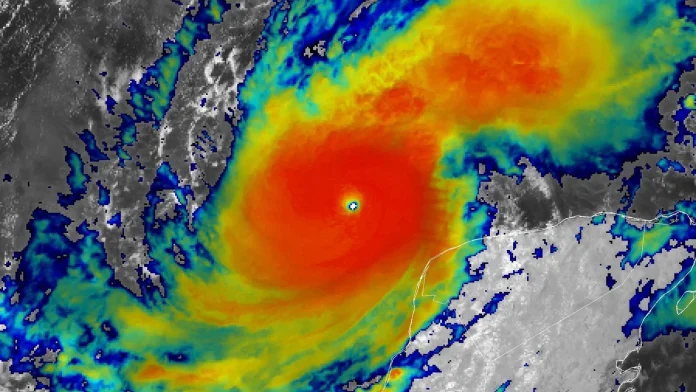[Click here to read in English]
Una vez más, es probable que la temporada de huracanes en el Atlántico de 2025 sea inusualmente activa, según el último pronóstico estacional del equipo de predicción de huracanes de la Universidad Estatal de Colorado, publicado el 3 de abril. Liderado por Phil Klotzbach, con la colaboración de Michael Bell y Levi Silvers, el equipo de CSU pronosticó 17 tormentas con nombre, nueve huracanes, cuatro huracanes de gran intensidad y una Energía Ciclónica Acumulada (ACE, por sus siglas en inglés) de 155, un 26 % por encima del promedio.
Esta cifra es superior a los promedios a largo plazo del período 1991-2020, que registró 14.4 tormentas con nombre, 7.2 huracanes, 3.2 huracanes de gran intensidad y un ACE de 123. El año pasado hubo 18 tormentas con nombre, 11 huracanes, cinco huracanes de gran intensidad y un ACE de 162. En la última década, solo dos temporadas de huracanes en el Atlántico tuvieron un ACE significativamente por debajo del promedio 1991-2020: 2022 y 2015.
El pronóstico de CSU también prevé una mayor probabilidad de que un huracán de gran intensidad toque tierra en EE. UU.: 51 % (promedio a largo plazo: 43 %). Además, asigna un 26 % de probabilidad de que un huracán de gran intensidad impacte la costa este o la península de Florida (promedio a largo plazo: 21 %) y un 33 % para la costa del Golfo (promedio a largo plazo: 27 %). Para el Caribe, se estima un 56 % de probabilidad de que al menos un huracán de gran intensidad pase por la región (promedio a largo plazo: 47 %).
El pronóstico de CSU se basa en un modelo estadístico desarrollado a partir de más de 40 años de datos históricos sobre huracanes en el Atlántico, complementado con modelos dinámicos de cuatro centros de predicción: ECMWF (modelo europeo), UKMET, la Agencia Meteorológica de Japón y el Centro Euro-Mediterráneo sobre el Cambio Climático (CMCC).

Las temperaturas de la superficie del mar en la Región Principal de Desarrollo de huracanes, ubicada entre África y Centroamérica entre los 10-20°N, fueron aproximadamente 0.5°C (0.9°F) por encima del promedio en la mitad occidental, pero 0.5°C (0.9°F) por debajo del promedio en la mitad oriental. Prácticamente todas las ondas tropicales africanas atraviesan la Región Principal de Desarrollo, y estas ondas tropicales son responsables del 85 % de los huracanes de gran intensidad en el Atlántico y del 60 % de todas las tormentas con nombre. Durante la temporada de huracanes, temperaturas de la superficie del mar superiores al promedio en esta región suelen favorecer una temporada activa, siempre que no haya un evento de El Niño. Por el contrario, cuando las temperaturas son más frías de lo normal, es más probable que la temporada de huracanes en el Atlántico esté por debajo del promedio. (Crédito de la imagen: tropicaltidbits.com).
El equipo de CSU citó dos razones principales para su pronóstico por encima del promedio para 2025:
Es probable que las condiciones de ENSO neutral o una La Niña débil se presenten este otoño.
La Niña conditions in the Eastern Pacific have been weak in recent months, and most models are either forecasting neutral or weak La Niña conditions for the peak of the Atlantic hurricane season. NOAA’s Climate Prediction Center, in its latest March 13 monthly advisory, predicted a 49% chance of neutral conditions, a 38% chance of La Niña, and a 13% chance of El Niño for the peak of the Atlantic hurricane season.
El Niño conditions favor a slower-than-usual Atlantic hurricane season as a result of an increase in the upper-level winds over the tropical Atlantic that can tear storms apart (higher vertical wind shear). In contrast, when neutral or La Niña conditions are present, an active hurricane season becomes more likely. Since 1950, U.S. landfalls by major hurricanes have been more than twice as likely during a La Niña year compared to an El Niño year.
Patrones de temperatura del océano
Currently, sea surface temperatures are much warmer than normal in the western and central Atlantic, as well as in the eastern subtropical Atlantic. In contrast, sea surface temperatures in the eastern tropical Atlantic are near or slightly below average (Fig. 1). The increase in temperature in the eastern subtropical Atlantic and the Caribbean tends to correlate with what is observed in April before active hurricane seasons in the Atlantic.
As is their usual practice, the CSU team included the following standard warning:
“Coastal residents are reminded that it only takes one landfalling hurricane to make the season active for them. Precautions should be taken and preparations made for each season, regardless of the predicted level of activity.”
Años análogos
Five years with similar atmospheric and oceanic conditions in the preceding months (January, February, and March) were selected as “analogous years” to the 2025 hurricane season. These years occurred in the second year after an El Niño event and had La Niña conditions in January-February of the corresponding year. Additionally, they had above-average sea surface temperatures in the tropical and subtropical Atlantic.
The analogous years were:
- 1996 (13 named storms, 9 hurricanes, and 6 major hurricanes)
- 1999 (12 named storms, 8 hurricanes, and 5 major hurricanes)
- 2006 (10 named storms, 5 hurricanes, and 2 major hurricanes)
- 2008 (16 named storms, 8 hurricanes, and 5 major hurricanes)
- 2011 (19 named storms, 7 hurricanes, and 4 major hurricanes)
- 2017 (17 named storms, 10 hurricanes, and 6 major hurricanes)
The average activity for these years was 14.5 named storms, 7.8 hurricanes, 4.7 major hurricanes, and an ACE of 154, above-average activity levels. Among these analogous years, 2017 was particularly notable, with three category 4 hurricanes making landfall in the U.S.: Harvey, Irma, and Maria. However, 2006 was a quiet season, with no hurricanes making landfall anywhere in the Atlantic.
A warning: April forecasts for hurricane season have little to no accuracy
On average, April forecasts for hurricane season activity have shown little to no accuracy, and even negative accuracy when evaluated using the Mean Square Skill Score. This does not mean that a specific April forecast is incorrect, but rather that, in general, a forecast based solely on historical climatology could be equally or more accurate.
April forecasts must face the so-called spring predictability barrier. During this month, the El Niño/La Niña phenomenon tends to undergo rapid changes from one state to another, making it difficult to predict whether El Niño, La Niña, or neutral conditions will prevail in the upcoming hurricane season.
In April 2024, CSU predicted an extremely active season: 23 named storms, 11 hurricanes, 5 major hurricanes, and an ACE of 210. The forecast was quite accurate, as actual activity was 18 named storms, 11 hurricanes, 5 major hurricanes, and an ACE of 162. However, their April forecasts in 2023 and 2022 were not as precise.
The next CSU forecast, scheduled for June 11, deserves special attention, as forecasts made in late May and early June have shown considerable accuracy over the years.
Other forecasts in preparation:
- NOAA will release its first seasonal hurricane forecast for 2025 in late May.
- The private British firm Tropical Storm Risk, Inc. will issue its next forecast for the 2025 Atlantic hurricane season on April 7. Their initial forecast, released on December 10, anticipated 15 named storms, 7 hurricanes, 3 major hurricanes, and an ACE index of 129. They indicated that the accuracy of a forecast made so far in advance was only 0-4%.
Bob Henson contributed to this article.




